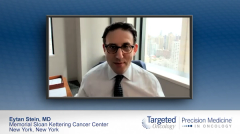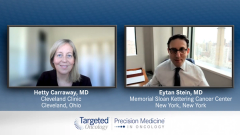
Diagnosis and Cytogenetic Testing in AML
Hetty Carraway, MD, discusses the process of diagnosing acute myeloid leukemia and its clinical subtypes.
Episodes in this series

Eytan Stein, MD: Dr Carraway, how is AML [acute myeloid leukemia] diagnosed?
Hetty Carraway, MD: Many of our patients present with issues related to their bone marrow factory no longer working. They often present with bleeding, bruising, fatigue, and shortness of breath, especially with exertion. They will be doing their usual daily activities and are limited in ways that they previously weren’t. With that, many patients present to either their primary care doctor or an emergency department with these symptoms. Some patients have fevers and present like [they have] an infection.
In the work-up of these scenarios, whether it’s in the primary care physician’s office or the emergency department, patients will have a complete blood count performed. Often, there are aberrations in the white blood cell count, red blood cell count, and platelet count. As a result of that, a bone marrow biopsy is often pursued, especially if the blast percentage isn’t greater than 20% in the peripheral blood. If it’s greater than 20% in the peripheral blood, then we know we have a leukemia on our hands, and we have to determine whether it’s an acute or chronic leukemia. We use special tests in the laboratory on the peripheral blood or, more often, the gold standard is to do a bone marrow biopsy.
The bone marrow biopsy and the peripheral blood can be evaluated using a flow cytometry test to look at the surface markers on the cancer cells or the blast cells. There are other informative tests, such as the comprehensive cytogenetics, which is often sent off of the bone marrow aspirate, as well as the FISH [fluorescence in situ hybridization] test to look for cytogenetic changes. Then, as you alluded to, these cancer cells can also have mutations, so the standard of care is to also look at the myeloid mutation profile with next-generation sequencing. In addition to that, the bone aspirate is looked at under the microscope by pathologists to see where that block in differentiation is to get a better sense of exactly what kind of leukemia this is based on the morphology and the chromosome changes and mutational changes. Dr Stein, I’m going to turn to you. What are the different types of AML?
Eytan Stein, MD: That’s a very good question that isn’t easily answered because the World Health Organization has defined many different subtypes of acute myeloid leukemia based on the cytogenetics and molecular genetics that are found in each patient. As we were both talking about, there are many ways to getting to 20% blasts in the blood or in the bone marrow. The most common and most well-established ways of getting to 20% blasts have been codified as subtypes of acute myeloid leukemia. For example, there’s a category called acute myeloid leukemia with recurrent genetic abnormalities. That’s a broad list of cytogenetic and molecular genetic abnormalities that classify patients into different groups.
For the purposes of the community oncologist though, how the WHO classifies acute myeloid leukemia—except in 1 particular situation, which I’ll talk about in a second—isn’t particularly important when it comes to choosing the right treatment for the patient because the right treatment is going to be based on potentially cytogenetics and molecular genetics that aren’t necessarily carved out as a specific subcategory. As we get further on in the discussion, you’ll see what we mean about that.
The one subtype that every community oncologist needs to know about is a separate subtype called acute promyelocytic leukemia [APL]. That’s important to know because the treatment for acute promyelocytic leukemia is the combination of all-trans-retinoic acid [ATRA] and arsenic trioxide. If you think a patient might have acute promyelocytic leukemia, it’s important to give that patient ATRA right from the get-go. You don’t even need to wait for any diagnostic test to be done. ATRA is low risk. It doesn’t really have any adverse effects. But if the patient ends up having APL, by starting ATRA immediately, you’ll significantly improve their chances of not having a bleeding complication.
Dr Carraway, let’s get a little into the weeds about the types of cytogenetic and molecular genetic alterations seen in patients with acute myeloid leukemia. The first thing that’s important is what cytogenetic test and maybe molecular genetic tests should always be ordered for a newly diagnosed patient with AML? Is it important to wait for the results of those tests before initiating treatment?
Hetty Carraway, MD: Thank you for that question. Getting into the weeds on this matters because it helps us profile the leukemia in terms of the biology of the leukemia itself. For many of our patients, they’ll undergo a bone marrow biopsy and aspirate. From that aspirate, we’ll send off a test called comprehensive cytogenetics where we grow the cells and look to see what the chromosomes look like. For about 50% of patients with AML, and for a little more than 50% of older patients with AML, there will be cytogenetic abnormalities that we can detect looking at the chromosome changes. That’s a very important test that’s essential for the work-up of any patient with AML. We often make sure that at least 20 cells are grown and evaluated in that setting.
For some, in addition to doing the comprehensive cytogenetics, we also send off a fluorescence in situ hybridization, or a FISH test, looking for classic chromosomal abnormalities in diagnosing AML. For some institutions, including mine, we’ll do the comprehensive cytogenetic test. If those cells don’t grow, then we reflex to do the FISH testing. Other institutions do both right from the start, where they do comprehensive cytogenetics and get the FISH testing at the same time. The benefit is that FISH testing often comes back a little faster than the comprehensive cytogenetics. The comprehensive cytogenetics can take 2 weeks to come back or, for some institutions, longer. The FISH test will often come back in about 3 to 5 days, so these cytogenetic changes help us understand whether the biology of this leukemia is emerging from an underlying antecedent hematologic malignancy like MDS [myelodysplastic syndromes] or a de novo AML.
Another test is a molecular test called next-generation sequencing that looks at a panel of chains. That panel is anywhere between 30 to 60 or maybe even 100 chains, depending on what institution you’re from. But by and large, there are maybe 7 to 10 genes that help guide some of our decisions with regard to whether it’s a favorable-risk leukemia or a leukemia that’s more likely to relapse despite going into remission with intensive chemotherapy. Some of those mutations, such as FLT3, NPM1, IDH1, IDH2, or even TP53, are important in the decision-making process, even [when] just talking with patients about the short-term picture as well as the overarching larger picture.
Some questions remain around whether we should wait 2 weeks for this information to come back or embark on therapy without knowing that information. It depends. For some, if it takes a month to get that information back, we wouldn’t want to wait. We’d want to get started on therapy. Many of us get started on therapy and don’t wait for the cytogenetic or molecular information and parse out some of the decisions based on the patients’ performance status and comorbidities.
Other institutions are able to get that information in a short period of time—even 3 to 7 days—so they can wait. We’ve learned and there are data that show that for patients who are older—over the age of 60 or 65 [years]—that it’s safe for some of them to wait the 2 weeks to get that comprehensive cytogenetic and mutational data back to make the best decision for their therapy. For some, it's even [safe] over the age of 75 to make some of those decisions, although I’d argue that with comorbidities for many of our patients over the age of 75, we may already know what direction we’re headed in terms of therapy.
Transcript edited for clarity.












































